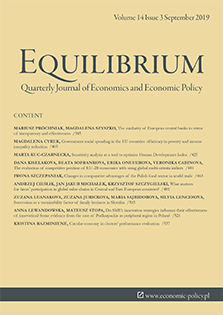Government social spending in the EU countries: efficiency in poverty and income inequality reduction
Government social spending in the EU countries: efficiency in poverty and income inequality reduction
Author(s): Magdalena CyrekSubject(s): Micro-Economics, Economic policy, Government/Political systems, Welfare systems, Welfare services, Economic development, EU-Approach / EU-Accession / EU-Development, Public Finances
Published by: Instytut Badań Gospodarczych
Keywords: government expenditure; poverty; inequality; efficiency;
Summary/Abstract: Research background: Income inequality and poverty attract a lot of attention among politicians, activists as well as scientists, who are trying to find a solution to these socio-economic problems. State intervention is commonly expected in this field, however, there is no agreement about the most efficient methods and instruments, as well as about the scale of public expenditure for the purpose of limiting poverty and inequality. Purpose of the article: The aim of the paper is to specify efficiency of government social spending in reducing problems of poverty and income inequality in the EU countries. Moreover, the attention is paid to changes in the efficiency in a period of the 2007 crisis occurrence and its overcoming and to sources of the changes. Methods: To fulfill the main goal of the paper, the DEA method is used, which enables to compare the social efficiency of the EU countries. The Malmquist index is also calculated and decomposed to identify changes in the efficiency and their sources in the crisis period. Data used in the analyses were obtained from Eurostat and OECD databases and cover the period from 2007 to 2016 year. Findings & Value added: The main findings of the paper shed some light on the differences in social efficiency of government spending in the EU countries. Generally, the countries with a higher level of social spending are also those with lower efficiency in inequality reduction, however, the relationship doesn’t appear for poverty alleviation. Thus, the research suggests some substitution between the scale and the efficiency of social spending, at least for the inequality dimension. Moreover, some differences in a social model can be found between the countries of the South and of the North: the countries of the South focus their social policy mainly on inequality reduction, while the Scandinavian countries as well as some other affluent societies direct their public support mainly on poverty alleviation. The research also shows that in the crisis period decreases in efficiency concerned mainly the poverty dimension. It reflects the fact that the poor were the losers of the crisis in favor of the middle classes. The efficiency losses were induced by negative changes in the current usage of public sources, while institutional reforms positively influenced the efficiency.
Journal: Equilibrium. Quarterly Journal of Economics and Economic Policy
- Issue Year: 14/2019
- Issue No: 3
- Page Range: 405-424
- Page Count: 20
- Language: English

